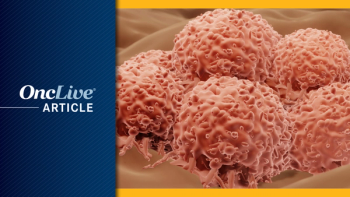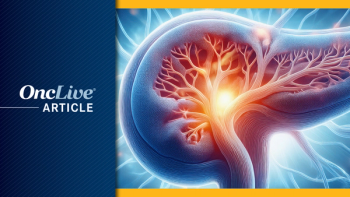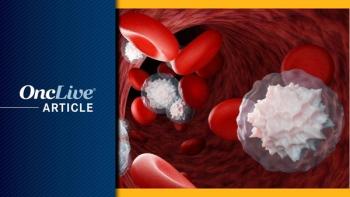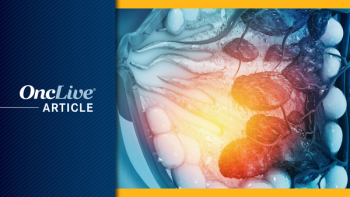
Tolinapant Displays Encouraging Activity and Safety in Relapsed/Refractory PTCL/CTCL
Single-agent tolinapant generated promising response rates with a manageable safety profile in patients with relapsed/refractory peripheral T-cell lymphoma and cutaneous T-cell lymphoma, according to data from the phase 2 ASTX660-01 trial.
Single-agent tolinapant (ASTX660) generated promising response rates with a manageable safety profile in patients with relapsed/refractory peripheral T-cell lymphoma (PTCL) and cutaneous T-cell lymphoma (CTCL), according to data from the phase 2 ASTX660-01 trial (NCT02503423).
Findings presented at the 2022 EHA Congress showed that among evaluable patients with PTCL (cohort 3; n = 96), tolinapant produced a best overall response rate (ORR) of 22.9%, which included a complete response (CR) rate of 9.4% and a partial response (PR) rate of 13.5%). Additionally, 16.7% of patients had stable disease, and 60.4% experienced disease progression. The median duration of response (DOR) was 6.5 months (range, 1.5-45.1), and the median time to response was 56.0 days (range, 48-173).1
In evaluable patients with CTCL (cohort 4; n = 50), tolinapant elicited a best ORR of 28.0%, which included CR and PR rates of 4.0% and 24.0%, respectively. Fifty-two percent of patients had stable disease, and 20% had progressive disease. The median DOR was 8.8 months (range, 1.0-43.0) and the median time to response was 55.5 days (range, 20-258).
“Most patients who had a response had it at the first evaluation, but we also observed the first response at cycle 2, cycle 4, [and beyond in the PTCL cohort],” said Jean-Marie Michot, MD, lead study author and a practitioner in Internal Medicine and an investigator in the Drug Development Department at Gustave Roussy Institute in Villejuif, France, during a presentation of the data. “Similarly, in the CTCL cohort, we observed some patients who reached response at the first assessment, but also in cycle 2 and up to cycle 9.”
Tolinapant is a novel, oral non-peptidomimetic antagonist inhibitor of apoptosis proteins. The agent demonstrated antagonism of XIAP and cIAP1 on purified proteins, cells, and in vivo in xenograft models.2 In the phase 1 portion of the ASTX660-01 trial, low efficacy was observed in other tumor types, although the recommended phase 2 dose (RP2D) was achieved, and the agent was well tolerated with minimal myelosuppression.3
In the phase 2 portion of the research, six cohorts each enrolled 30 patients with various malignancies, including head and neck squamous cell carcinoma (cohort 1), diffuse large B-cell lymphoma (cohort 2), PTCL (cohort 3), CTCL (cohort 4), other cell tumor type (cohort 5), and cervical carcinoma (cohort 6). Based on responses, cohorts 3 and 4 were expanded, with approximately 100 total patients with PTCL and approximately 50 total patients with CTCL enrolled.
To enroll in cohorts 3 or 4, patients were required to have PTCL or CTCL with evidence of documented progressive disease after at least 2 prior lines of systemic therapy. Patients with CD30-positive disease must have received, been ineligible for, or been intolerant of brentuximab vedotin (Adcetris). Patients with mycosis fungoides or Sezary syndrome must have received, been ineligible for, or been intolerant to mogamulizumab-kpkc (Poteligeo). Measurable disease per CT scan was required for patients with PTCL, and all patients were required to have adequate organ function.
Patients were excluded from the trial if they had cardiac disease; underwent systemic therapy, including CAR T-cell therapy, with 2-6 weeks of study treatment; or received systemic steroids at more than 20 mg of the prednisone equivalent.
Once enrolled, all patients received the RP2D of oral tolinapant at 180 mg per day for days 1 through 7 and 15 through 22 of each 28-day cycle.
The primary end point of the phase 2 portion of the trial was ORR, based on the 2014 Lugano classification for PTCL and the Global Assessment for CTCL. Secondary end points included DOR, progression-free survival, pharmacokinetics, pharmacodynamics, and exploration of potential biomarkers.
Among all patients in the PTCL cohort (n = 99), the median age was 63 years (range, 27-82), 67.7% were male, and the median number of prior therapies received was 3. In all patients in the CTCL cohort (n = 51), the median age was 62 years (range, 24-87), 58.8% were male, and the median number of prior therapies received was 6.
PTCL subtypes included PTCL–not otherwise specified (45.5%), angioimmunoblastic T-cell lymphoma (34.3%), anaplastic large cell lymphoma (5%), and other (15.2%). CTCL subtypes included mycosis fungoides (56.9%), mycosis fungoides with large cell transformation (17.6%), Sezary syndrome (17.6%), and other (7.8%).
Additional data showed that patients with PTCL experienced a median PFS of 1.8 months with tolinapant monotherapy and a median OS of 15.4 months. In patients with CTCL, treatment with tolinapant resulted in a median PFS of 5.5 months and a median OS of 40.7 months.
Biopsy and plasma samples collected from patients with PTCL following treatment showed evidence of increased immune cell recruitment and soluble immune mediators, which was consistent with preclinical models.
Regarding safety, at least 1 treatment-emergent adverse effect (TEAE) of any grade occurred in 79.9% and 80.4% of patients in the PTCL and CTCL cohorts, respectively. The most common any-grade TEAEs reported in the PTCL cohort included increased lipase (35.4%), increased amylase (27.3%), rash (26.3%), fatigue (16.2%), increased aspartate aminotransferase (AST; 16.2%), increased alanine aminotransferase (ALT; 15.2%), diarrhea (10.1%), thrombocytopenia (9.1%), nausea (9.1%), and anemia (9.1%).
The most common any-grade TEAEs observed in the CTCL cohort included increased lipase (37.3%), rash (25.5%), increased amylase (23.5%), diarrhea (17.6%), increased ALT (15.7%), increased AST (15.7%), nausea (11.8%), tumor flare (11.8%), anemia (11.8%), increased alkaline phosphate (9.8%), and decreased appetite (9.8%).
AEs of note included facial nerve disorder, which occurred in 3 patients in the PTCL cohort and 1 patient in the CTCL cohort; one of these cases was grade 3, and the other three were all grade 2 or less. Cytokine release syndrome occurred in 2 patients in the PTCL cohort.
Among all patients from the PTCL and CTCL cohorts, 45.3% experienced at least one grade 3 or higher TEAE. The most common TEAEs included increased lipase (15.3%), rash (10.7%), increased amylase (6.7%), anemia (4.7%), thrombocytopenia (4.7%), neutropenia (4.0%), and febrile neutropenia (2.0%). Notably, severe cutaneous toxicities were more common in the CTCL cohort, and the incidence of asymptomatic pancreatic enzyme elevation was similar across both cohorts.
Tolinapant is under further investigation in a phase 1/2 trial (NCT05403450), where the agent is being evaluated in combination with oral decitabine and cedazuridine (Inqovi) in patients with relapsed/refractory PTCL.
References
- Michot J-M, Mehta A, Samaniego F, et al. Preliminary analysis of the phase II study using tolinapant (ASTX660) monotherapy in 98 peripheral T-cell lymphoma and 51 cutaneous T-cell lymphoma subjects with relapsed refractory disease. Presented at: 2022 EHA Congress; June 9-12, 2022; Vienna, Austria. Abstract S217
- Ward G, Lewis EJ, Ahn JS, et al. ASTX660, a novel non-peptidomimetic antagonist of cIAP1/2 and XIAP, potently induces TNFα-dependent apoptosis in cancer cell lines and inhibits tumor growth. Mol Cancer Ther. 2018;17(7):1381-1391. doi:10.1158/1535-7163.MCT-17-0848
- Ferrari N, Ward G, Gewinner C, et al. Antagonism of inhibitors of apoptosis proteins reveals a novel, immune response-based therapeutic approach for T-cell lymphoma. Blood Adv. 2021;5(20):4003-4016. doi:10.1182/bloodadvances.2020003955

























































































